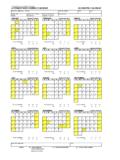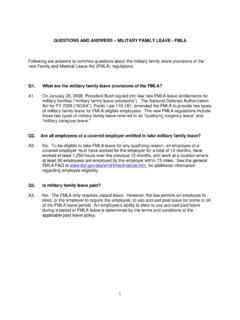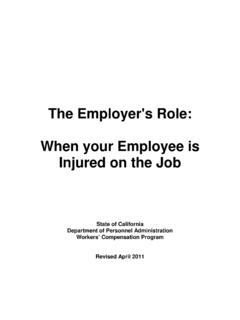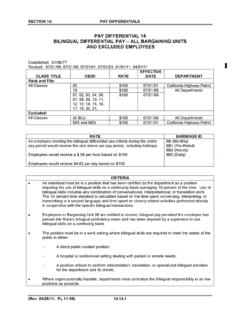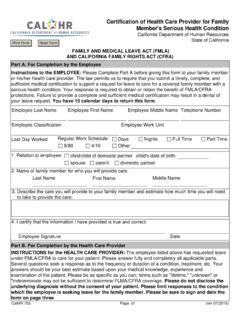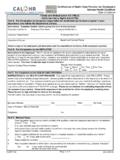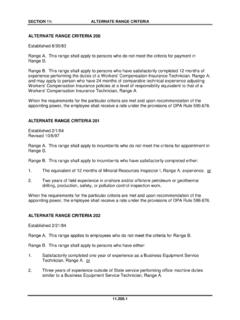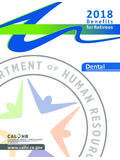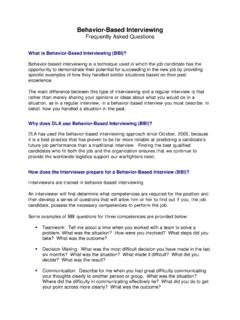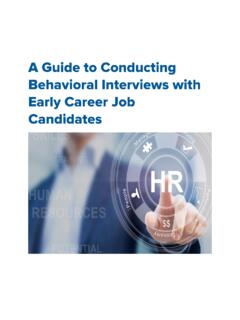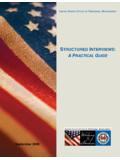Transcription of EXECUTIVE BEHAVIORAL INTERVIEW GUIDE - California
1 EXECUTIVE BEHAVIORAL INTERVIEW GUIDE . INTERVIEW GUIDE INSTRUCTIONS: This INTERVIEW GUIDE is intended to help hiring executives conduct BEHAVIORAL interviews for EXECUTIVE classifications covered by the State of California Leadership Competency Model (Leadership Competency Model). This GUIDE has been designed to apply to Career EXECUTIVE Appointments (CEA). However, departments may also use it to assist them in filling CEA-level Exempt positions. Before using this GUIDE , you should contact your Human Resources Staff to ensure that you follow any internal procedures and formats required by your department. For more information and tips on the selection process, you can access the Virtual Help Desk for Supervisors and Managers at For an overview on the California Merit Principle, please access BEHAVIORAL - based interviewing is based on the concept that the best predictor of a candidate's future performance is his or her past performance.
2 Therefore, BEHAVIORAL INTERVIEW questions are built around specific incidents that have happened rather than hypothetical situations. The interviewer asks the candidate to describe what they have actually done rather than what they would do in a what if situation. The Leadership Competency Model describes the general competencies and behaviors required for successful performance as an EXECUTIVE with the State of California . The BEHAVIORAL INTERVIEW questions included in this GUIDE have been developed to elicit information about a candidate's past experiences that relate to the behaviors (described in the Leadership Competency Model). required to successfully perform as an EXECUTIVE in the State of California .
3 Descriptions of successful and non-responsive BEHAVIORAL indicators are included to help assess the candidate's responses. For more information on BEHAVIORAL interviewing , please access For information on BEHAVIORAL based reference checks, please access Before the INTERVIEW : Review the candidate's application and resume Review the critical job specific general competencies and the successful BEHAVIORAL indicators that demonstrate each competency on the job Identify the general competencies that will be asked about as part of the INTERVIEW . One way to decide which competencies to include in the INTERVIEW is to consider the competencies that are required to successfully perform the most critical job duties as identified in the job description Identify the set of questions which will be asked during the INTERVIEW process (The interviewers do not need to include all of the questions for each competency).
4 Work with your Human Resources staff to identify any questions specifically related to the organization, the classification or the job specific technical competencies Tips for customizing this INTERVIEW GUIDE for your interviews: HR Modernization Project Page 1 Last Revision June 20, 2011. To obtain a customizable version of this GUIDE , please contact us. Once you receive the copy, use the File Save As feature. Edit the document so that it includes only the job related general competencies that you have identified for inclusion in your interviews. Edit the document so that the set of BEHAVIORAL INTERVIEW questions provided for each general competency include only those questions that you have identified for inclusion in your interviews.
5 Edit the document so that it includes only the successful and non-responsive BEHAVIORAL indicators that you expect to be elicited based on the selected competency questions. Add any questions specifically related to the organization, the classification or the job specific technical competencies along with the expected successful and non-responsive BEHAVIORAL indicators. Make a copy of the INTERVIEW GUIDE for each interviewer to use to take notes on each candidate to be interviewed. On the INTERVIEW GUIDE for each candidate each interviewer should fill in the following information: o The INTERVIEW information ( candidate name, interviewer name, INTERVIEW date, position being filled).
6 O The Education and Experience from the candidate's application (during the INTERVIEW , notes can be added based on what the candidate shares about their education and experience). Conducting the INTERVIEW : Welcome the candidate and make them comfortable Provide the candidate with a copy of the questions that will be asked in the INTERVIEW (optional). Begin the formal INTERVIEW by briefly reviewing the candidate's education and experience Ask the same questions of each candidate being interviewed for the same position Tell the candidate about the job and the organization Clarify any questions about the candidates education and work experience that are necessary ( fill in gaps).
7 Ask questions and follow-up to probe for details and accomplishments ideally at least 2 3 examples in each area. Get complete examples which include: The circumstances that the candidate encountered The actions that the candidate took The outcome of the actions taken Use this GUIDE to take notes and assess the candidates Exceptional performance in the INTERVIEW or performance in the INTERVIEW that does not meet expectations must be indicated in the notes section of the INTERVIEW GUIDE for a particular question and competency. Select the appropriate BEHAVIORAL indicators based on the candidate's responses and summarize key observations and notes. Rate the candidate on each competency in the space provided at the bottom of each page.
8 After the INTERVIEW : After completing each INTERVIEW , interviewers should discuss the final ratings for each candidate and complete the Overall Candidate Rating. After all interviews are completed, check references, check personnel files; make hiring decision. HR Modernization Project Page 2 Last Revision June 20, 2011. Candidate Name: Interviewer Name: INTERVIEW Date: Position Being Filled: HR Modernization Project Page 3 Last Revision June 20, 2011. EDUCATION AND EXPERIENCE. Education: Experience: HR Modernization Project Page 4 Last Revision June 20, 2011. BEHAVIORAL INTERVIEW Questions FOSTERING A TEAM ENVIRONMENT CLUSTER. Communication Questions Describe a situation where you demonstrated that providing and receiving feedback from others is important for all employees throughout the organization.
9 O What did you do? o Who was feedback provided to? o Who was feedback received from? o What was the result? Describe a situation where you demonstrated that listening and interacting with others are important skills for all employees throughout the organization. o What did you do? o What was the result? Describe a time when you were able to effectively communicate difficult, sensitive, or unpleasant information. o What was the situation? o What steps did you take to ensure that your audience understood the information? o What was the outcome? Describe a situation where you successfully persuaded others to do something or to see your point of view. o What was the situation?
10 O What did you do? o What was the result? Describe a situation where you had to convey an organizational decision that was controversial to your management team, your staff, or to employees throughout the organization. o What was the situation? o What did you do? o What was the result? Tell us about a time when you had to coach other leaders on presenting sensitive and complex information in a manner that could be easily understood. o What did you do? o What was the outcome? o What techniques did you teach the other leaders to use to confirm that the audience understood the information? HR Modernization Project Page 5 Last Revision June 20, 2011. Communication Questions (Continued).

